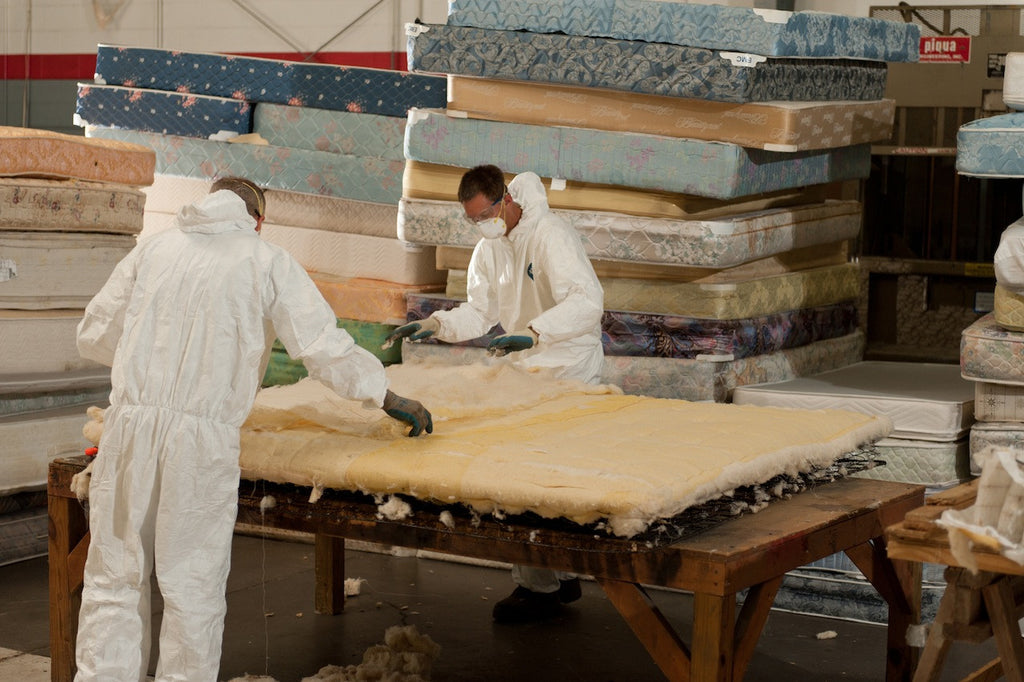Our Bodies Are Vulnerable When We Sleep
Sleep is critical to our health. Our bodies are particularly vulnerable when we sleep because that’s the time when our bodies are trying to repair damage and reset. According to the National Sleep Foundation, sleep is when the body is performing muscle repair, releasing hormones, and performing other critical health functions. And we spend more time in bed than any other place — one third to one half of our lives.
Our bodies’ vulnerability during sleep and the amount of time we spend in bed make it important to assess the safety of our sleep environments. Are we being exposed to unnecessary risk by the toxic materials in our bedrooms?
Toxic Chemicals in Your Mattress
Mattress marketing is anything but transparent. Many companies market their mattresses as “natural” or even “organic” when they are far from it. Mattress manufacturers aren’t required to disclose what’s in your mattress, but independent testing has confirmed that most mattresses are packed with toxic chemicals. These include polyurethane foam, which is a petroleum-based material that emits VOCs; formaldehyde; and boric acid, which is commonly used as a poison for killing roaches. Some memory foam mattresses, which are made of polyurethane foam, have been found to emit 61 chemicals, including the carcinogens benzene and naphthalene.
Take Tempur-Pedic, for example. The mattress manufacturer has long denied and downplayed any danger from the strong odors associated with memory foam, and they have explicitly stated that their mattresses are “free of harmful VOCs such as formaldehyde and CFC.” But there is currently a class-action lawsuit pending against Tempur-Pedic regarding their mattresses’ emissions of formaldehyde (a known carcinogen) and other harmful VOCs.
We count on government regulations to keep us safe from things like hidden toxins, but there’s one government regulation that actually encourages their use. State and federal regulations require mattresses to be highly flame retardant. To comply with these regulations, manufacturers often add toxic flame-retardant chemicals instead of natural flame-retardant materials such as wool. Some of the most dangerous flame-retardants, polybrominated diphenyl ethers (PBDEs), have been banned due to health concerns. Research has revealed that children born to women who were exposed to high levels of PBDEs during pregnancy had, on average, a 4.5-point decrease in IQ. These children are more prone to other health issues, as well.
Although newer mattresses do not contain certain PBDEs, the chemicals that have replaced them can be just as bad. One class of flame retardants, organophosphate flame retardants (OPFRs), have been identified as known or suspected carcinogens or neurotoxic substances. Children are particularly vulnerable. A study conducted by Duke University and the Environmental Working Group that tested for one common flame retardant found evidence of exposure in the urine samples of every single mother and child tested. On average, the children had nearly five times more flame retardant metabolites in their urine than their mothers.
Manufacturers don’t have to reveal the ingredients in their flame retardants, and they don’t always test them for safety. According to Dr. Heather Stapleton of Duke University, under the EPA’s Toxic Substances Control Act of 1976, “If a flame retardant manufacturer wants to market a new flame retardant, they can go right ahead and do so without testing it for toxicity beforehand.” So, in effect, no one is necessarily even testing these chemicals before they end up in your home.
Choosing a Safe, Non-Toxic Mattress
With the lack of transparency in the mattress industry, consumers need to be especially vigilant when shopping for a non-toxic mattress. Closely examining the materials in a mattress — in great detail — is the only way to ensure your mattress won’t harm your health.
No Greenwashing — Many mattresses will use words like “healthy”, “eco friendly”, “pure”, “natural” or “non-toxic” when describing their mattresses. But, these words mean little, because there are no standard definitions for such marketing terms and no regulations or verification of claims in the mattress.
Certified Organic — Certification is the only way to know that the materials truly are what they claim to be. Look for trusted third-party certifications like GOTS (Global Organic Textile Standard), GOLS (Global Organic Latex Standard), GreenGuard, and USDA Organic, which are rigorously defined and enforced. You can’t be confident you have a non-toxic mattress unless you do.
Check All Materials — Make sure that all the materials in your mattress are certified organic. Many mattress marketers will call a mattress “organic” or even “certified organic” when only a very small portion of the mattress contains anything organic — if at all. If your mattress is made of toxic, polyurethane memory foam, but is partially covered with a little bit of organic or “natural” cotton, it is still a toxic, unhealthy mattress.
Again, don’t be fooled by slick mattress advertising with vague claims about “natural” or “organic” materials. Make sure your mattress is made of 100% certified organic, non-toxic materials. And, when shopping for an organic mattress, check the certifications. It’s the only way to be certain your mattress isn’t making you sick and causing serious, long-term health issues for you and your family.
